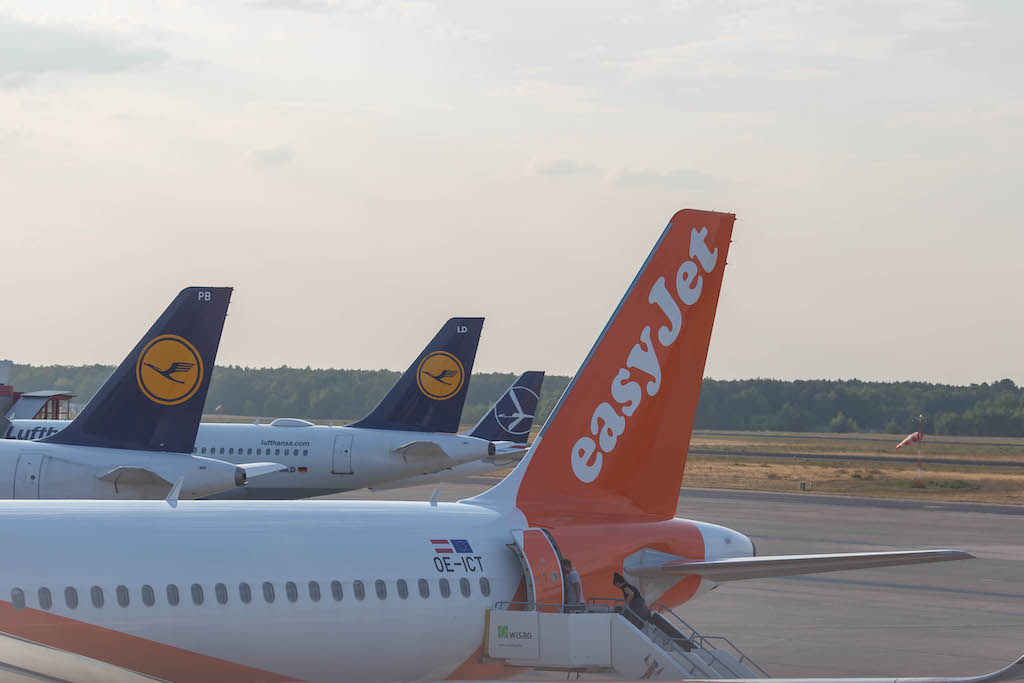Lufthansa, EasyJet Lean Into European Recovery as U.S. Flounders

Photo Credit: Flickr / Marco Verch
Lufthansa and EasyJet are looking keenly to the fall and winter as the European travel recovery seems to have found firm footing. This is a turning of the tables compared with their U.S. peers, which almost universally have lowered expectations for the fall after the Delta variant took a big bite out of their previously rosy outlooks.
"Current bookings indicate a sustained demand recovery," the Lufthansa Group said in a statement on a new €2.1 billion ($2.5 billion) capital increase on September 19. As such, the group — including its namesake carrier as well as Austrian Airlines, Brussels Airlines, Eurowings and Swiss — expects positive cash flow and an operating profit in the third quarter.
EasyJet said on September 18 that there was a "surge" in UK bookings for travel this fall and winter after the UK government removed pre-departure testing requirements for fully vaccinated travelers returning to the country, beginning October 4. The airline did not provide a base off of which bookings jumped. The UK represents half of EasyJet's scheduled capacity in September, according to Cirium data.
And earlier in September, Ryanair said strong pent-up demand was translating to stronger-than-expected bookings in October and through the fall.
Although no carrier is claiming that European travel has emerged from the crisis, the outlooks from three of the continent's largest carriers show growing optimism at a time when previously buoyant U.S. carriers are toning down the positive rhetoric. Earlier in September, most U.S. carriers — including Alaska Airlines, American Airlines, Delta Air Lines and United Airlines — pulled back on fall outlooks citing the negative impact of the Covid-19 Delta variant. United, as well as Southwest Airlines, were also among those that cited a slowdown to revise back expectations of a third-quarter profit.
“There’s still really robust sort of underlying demand in terms of leisure travel and a desire for business travel to pick back up,” Alaska Chief Financial Officer Shane Tackett said on September 9. “We’ve just got to get through this wave and hope that there’s not another one — or hope that we’ve all adopted [a] view of life where we’ve got the vaccine and we’re moving on.”
Pent-up demand or not, the U.S. travel outlook for the fall looks moribund as airlines await a delayed business travel recovery and the year-end spike in holiday leisure flyers.
It's a very different story in Europe. Corporate travelers are returning — whereas their numbers have plateaued in the U.S. — supporting Lufthansa's plans to resume more flights. In addition, the group anticipates U.S. restrictions on European travelers to ease by year-end allowing it to resume more transatlantic flights, which are a key moneymaker for Lufthansa. All of this comes as the group filled more seats while operating more flights than planned in August, and expects the same in September.
The growing divergence comes as European vaccination rates have surpassed those in the U.S. In addition, EU citizens are increasingly supportive of national proof-of-vaccination mandates for many indoor activities. These added restrictions are likely helping fuel the travel recovery, especially among corporations who must weigh their duty of care against the business upsides of sending roadwarriors back out on the road.
This positive picture is paying off for Europe's carriers. Lufthansa's capital increase will allow it to repay all of the German state aid that it received in 2020 by year-end, which is earlier than previously planned. The funding plan comes on the heels of a £1.2 billion ($1.6 billion) rights issue from EasyJet that proceeds from which will be used to fund growth and fortify the discounters position in key European airports. And J.P. Morgan Analyst David Perry wrote on September 17 that there is increasing pressure on IAG for a second rights issue after a £2.5 billion one in September 2020.
Lufthansa will use proceeds from its capital increase to repay the €1.5 billion Silent Participation I in German stabilization funds, and for working capital. It plans to pay off the remaining €1 billion Silent Participation II by year-end eliminating all remaining state obligations from its balance sheet.
“We have always made it clear that we will only retain the stabilization package for as long as it is necessary," said Carsten Spohr, CEO of Lufthansa Group, in a statement. "We can now fully focus on the further transformation of the Lufthansa Group.”
That transformation includes achieving €3.5 billion in structural cost savings by 2024 to become a more efficient carrier. The group has achieved roughly €2.1 billion of these savings, including €1.1 billion from workforce reductions alone. Lufthansa is also streamlining its fleet by replacing most four-engine jets — including the Airbus A380 superjumbo — with more efficient two-engine models like the Airbus A350, and consolidating its affiliate carriers.
